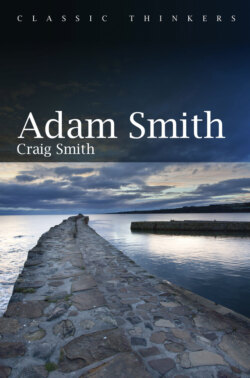Читать книгу Adam Smith - Craig Smith - Страница 20
Notes
Оглавление1 The general consensus among contemporary Smith scholars is that the Problem is a non-problem and based on a faulty reading by the German historical school. 2 Moral Sentiments, 287. 3 Also included in this volume is Smith’s short essay on the External Senses. This represents an engagement with the ideas of Berkeley and Locke on the nature of the relationship between our perception of external objects and the sensory organs of the body. 4 Astronomy, 33. 5 Astronomy, 41. 6 It is worth noting that this passage also marks the first of three appearances of the phrase ‘invisible hand’ in Smith’s works. Here the invisible hand is that of the Roman God Jupiter, marking the usage as distinct from the two later appearances of the term, which we will examine in subsequent chapters. 7 Astronomy, 50. 8 Astronomy, 45. 9 Astronomy, 96.10 Astronomy, 46.11 Astronomy, 66.12 Astronomy, 45.13 For a discussion of Smith on system, see Skinner, A System of Social Science; Phillipson, Adam Smith; and Schliesser, Adam Smith.14 Astronomy, 42.15 Astronomy, 74.16 Astronomy, 59.17 Ancient Physics, 107–8.18 Hutcheson, Inquiry, 39–40.19 Astronomy, 71.20 Astronomy, 89.21 The similarities between Smith’s theory and that of the twentieth-century philosopher of science Thomas Kuhn, with its division between normal science and paradigm shifts, has been widely noted, though it seems Kuhn was not aware of Smith’s essay as he developed his view.22 For a discussion of Smith’s relationship to Newtonianism see Montes, ‘Newtonianism and Smith’.23 The best short account of Smith’s theory of science is Berry, ‘Smith and Science’.24 Smith makes almost exactly the same observation in the Wealth of Nations when he points to ‘the beauty of systematical arrangement of different observations connected by a few common principles’ (Wealth of Nations, 768–9), and in his essay on the Imitative Arts published in the Essays on Philosophical Subjects showing how key it was to his conception of proper philosophy.25 See Berry, ‘Smith and Science’, for Smith as social scientist.26 Phillipson, Adam Smith, 92.27 The Essays on Philosophical Subjects also includes two short essays on ‘Of the Affinity between Music, Dancing, and Poetry and Of the Affinity between certain English and Italian Verses’, which may have formed part of Smith’s unrealized book on art and literature. For discussions of Smith’s aesthetics, see Labio, ‘Adam Smith’s Aesthetics’ and McKenna, Adam Smith.28 See de Marchi, ‘Smith on Ingenuity’.29 Imitative Arts, 183.30 Imitative Arts, 185.31 Rhetoric, 6.32 Rhetoric, 25–6.33 Rhetoric, 43.34 Rhetoric, 136.35 Rhetoric, 137. Smith also suggests that there is a difference in literary taste between the ‘ignorant’ and the ‘enlightened’ (Rhetoric, 111). The ‘vulgar’ are amused by fabulous tales of supernatural phenomena, while the refined prefer recognizable tales of human emotions.36 Rhetoric, 98.37 Rhetoric, 146.38 On Smith’s character sketches, see Heydt, ‘“A Delicate and an Accurate Pencil”’.39 For the classic statement on this, see Forbes, ‘Scientific Whiggism’.40 See David Hume’s argument in ‘Of the Original Contract’, Hume, Essays, 465–87.41 Ferguson, Essay, 14.42 Stewart, ‘Account of the Life and Writings of Adam Smith’, 293.43 Stewart, ‘Account of the Life and Writings of Adam Smith’, 293.44 See Land, ‘Adam Smith’s “Considerations”’ and Otteson, ‘Adam Smith’s First Market’.45 The approach is ubiquitous among the Scots and examples can be found in the work of Lord Kames, William Robertson, and a host of minor figures. Adam Ferguson operates with a variant of the approach which has three stages: savage, barbarian, and civilized.46 For the influence of Rousseau on Smith’s thinking see Rasmussen, The Problems and Promise.
